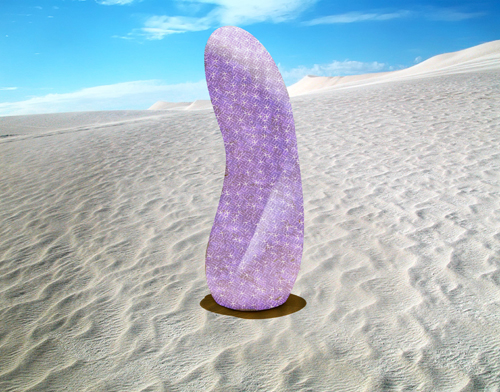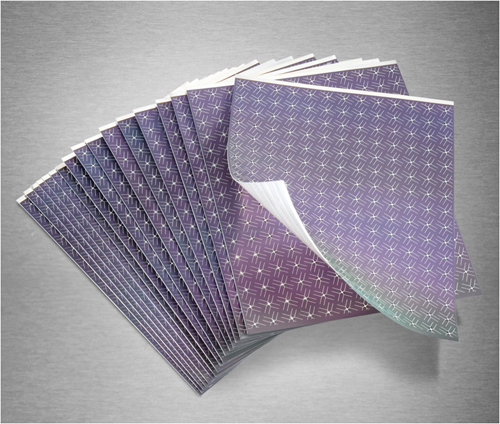

A re-working of Jean Arp’s 1942 Silencieux that I have dubbed Solarcieux
Nanosolar has announced the release to the market of its ultra-low cost (CIGS printed on aluminum foil back-contacted with metal-wrap-through design) nanoparticle ink flexible solar panels. A PDF of the details from the company can be downloaded here. This could be a real breakthrough in efficiency and affordability of CIGS (copper indium gallium selenide) technology. It is less energy intensive than silicon-based technologies in its production and achieves greater efficiencies in the field as high as 21% (the latest panels from nanosolar are only at 12% total panel efficiency, but the cost per square meter is significantly lower which is the major breakthrough).
How sustainable are the resources that go into CIGS?
As with many natural resources, total amount of copper on Earth is vast (around 1014 tons just in the top kilometer of Earth’s crust, or about 5 million years worth at the current rate of extraction). However, only a tiny fraction of these reserves is economically viable, given present-day prices and technologies. Various estimates of existing copper reserves available for mining vary from 25 years to 60 years, depending on core assumptions such as the growth rate.
Up until 1924, there was only about a gram of isolated indium on the planet. Indium is produced mainly from residues generated during zinc ore processing but is also found in iron, lead, and copper ores. Based on content of indium in zinc ore stocks, there is a worldwide reserve base of approximately 6,000 tonnes of economically-viable indium. This figure has led to estimates suggesting that, at current consumption rates, there is only 13 years’ supply of indium left. However, the Indium Corporation, the largest processor of indium, claims that, on the basis of increasing recovery yields during extraction, recovery from a wider range of base metals (including tin, copper and other polymetallic deposits) and new mining investments, the long-term supply of indium is sustainable, reliable and sufficient to meet increasing future demands. This conclusion also seems reasonable in light of the fact that silver, three times less abundant than Indium in the earths crust, is currently mined at approximately 18,300 tonnes per annum, which is 40 times greater than current indium mining rates.
Gallium does not exist in free form in nature, and the few high-gallium minerals such as gallite (CuGaS2) are too rare to serve as a primary source of the element or its compounds. Its abundance in the Earth’s crust is approximately 16.9 ppm. Gallium is found and extracted as a trace component in bauxite and to a small extent from sphalerite. The United States Geological Survey (USGS) estimates gallium reserves to exceed 1 million tonnes, based on 50 ppm by weight concentration in known reserves of bauxite and zinc ores. Some flue dusts from burning coal have been shown to contain small quantities of gallium, typically less than 1% by weight.
The reserve base for selenium is based on identified copper deposits. Coal generally contains between 0.5 and 12 parts per million of selenium, or about 80 to 90 times the average for copper deposits. The recovery of selenium from coal, although technically feasible, does not appear likely in the foreseeable future. An assessment of U.S. copper resources indicated that total copper resources in identified and undiscovered resources totals about 550 million metric tons, almost eight times the estimated U.S. copper reserve base.
Assuming that sustainable extraction and refining processes are set in place it seems that there is enough of the raw materials to continue to supply CIGS panels for the near term but probably not in the abundance necessary to replace any real significant amount of fossil-fuel-combustion energy production. It’s hard to say from the numbers and I’m not sure how much goes into each square meter of nano-technology based panel production. The “ink” is probably very thin.

But questions of sustainability aside, what is the most amazing part of the advancements in nanoparticle photovoltaic technology from the standpoint of its application to Land Art projects is the ability for the surfaces to be three-dimensionally applied and configured. One can easily imagine endless variations of sculptural forms with the surfaces feeding solar energy into a grid of collectors.
Related Posts
2 Comments
Leave a Reply to And Now For Something Completely Different Cancel reply
This site uses Akismet to reduce spam. Learn how your comment data is processed.

[…] posted about this idea back in 2009 with a tongue-in-cheek homage to Jean Arp’s 1942 Silencieux. But since then, the 2010 edition of the LAGI design competition has shown the world some truly […]
[…] application uses Nanosolar thin film solar cells to power a statue that is a homage to an earlier Jean Arp, non-generating, work of art, but which […]